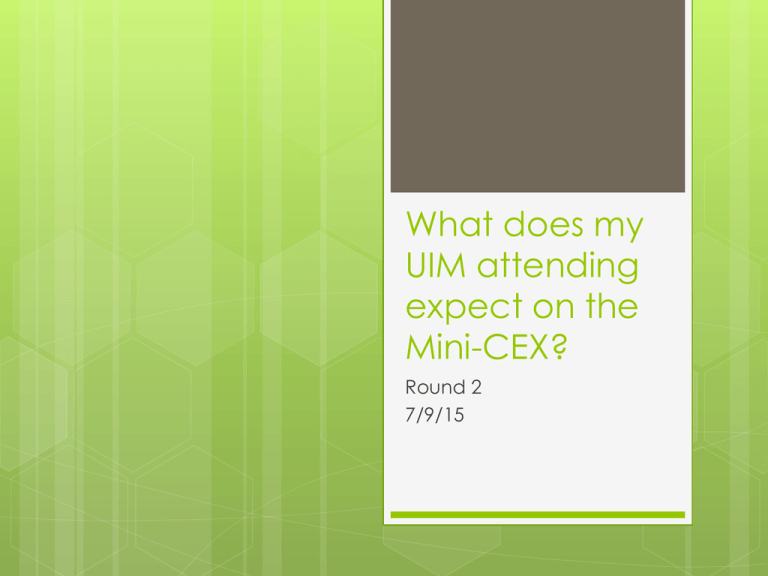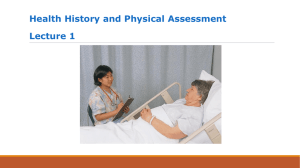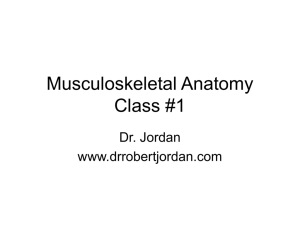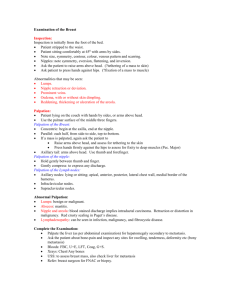What does my UIM attending expect on the Mini-CEX?
advertisement

What does my UIM attending expect on the Mini-CEX? Round 2 7/9/15 General Guides Mini-CEX - observed history and physical exam-board requirement of the ABIM Not a “sign off” Attending – will give you feedback; will not undermine your relationship with the patient Plan the Mini-CEX – no need to do this twice. Chief Complaint as your guide. General Guides Barbara Bates remains a great reference Tailor H/P to Chief Complaint/pertinence Gowns – do not auscultate through clothes! You need your H&P skills for outpatient Medicine Mini-CEX UIM 2013 Item Date 1. History of a new complaint 1. Medication history 1. Chronic pain history (psych) Focused physical exam 1. 1. CV exam 1. Lung exam 1. Abdominal exam 1. Musculoskeletal exam 1. Neurological exam 1. Pelvic exam (GYN) 1. Knee exam (Ortho) 1. Shoulder exam (Ortho) 1. Hip exam (Ortho) 1. Teach-back 1. Shared decisionmaking Supervisor CV Exam Which patients? Any complaint with cardiovascular elements Hypertension, CHF, CAD Especially good if you would like to verify findings CV Exam Heart Auscultation (follow V1-6) Diaphragm then bell Right upper sternal border Left upper sternal border Left midsternal border Left lower sternal border Apex Left Axilla Palpation - PMI, thrills, heaves Neck JVD 45 degree angle – find the top of the column Carotids Auscultation Ask patient to hold their breath Palpation Extremities Edema Peripheral pulses CV Exam Tips Feel the carotid pulse when listening to the heart Gallops are heard best with the bell Recall the grading system of murmurs and use this (1-6) and use “the language” Does the murmur radiate? Identify new murmurs, diastolic murmurs CV Exam tips You do not need to report cm of JVD – it’s OK to use landmarks. “With the patient at a 45 degree angle, JVD noted up to the earlobe” Differentiate murmurs from bruits in the carotids Lung Exam Auscultation Start at Apex and listen for symmetry side to side Listen anteriorly as well Ask patient to open his/her mouth to breathe Percussion – if needed only Consider in all patients with complaints (chest pain, SOB, etc.) or a history of lung/cardiac disease Especially good if you would like to verify findings Abdominal Exam Good for any complaint of abdominal pain Observation Auscultate before palpation Palpation – rebound if needed One quadrant with bowel sounds is enough All 4 quadrants; begin far from tender area Liver and spleen – start at the pelvic brim Ask patient to inhale; move your hands up after exhalation No need to press hard! Percussion – if needed Special maneuvers if suspected ascites Shifting dullness Succussion splash Hepatojugular reflux Abdominal Exam Percussion Liver edge – start at pelvic brim Used to estimate liver size Midclavicular line 6-12 cm Midsternal line 4-8cm Musculoskeletal Exam Symmetry Range of motion Strength (can be under neuro) Joints Synovitis – bogginess, heat, effusion, erythema Squeeze tenderness of MCP’s/MTP’s Nodules Tender areas (trigger points) Musculoskeletal Exam Musculoskeletal exam Patients with pain in multiple areas Patients with joint pain or stiffness Patient with weakness Neurological Exam Headaches Weakness Numbness/tingling History of “stroke” Equipment needed: reflex hammer, wooden cotton-tipped swab, low frequency tuning fork (the big one) Neuro Exam – basic elements Alertness and orientation Gait Cranial nerves (2-12 is sufficient) Muscle strength Grip, biceps, triceps, hip flexors/extensors, leg flexors/extensors, plantar flexion, dorsiflexion Reflexes – must do with an actual hammer! Pupils, EOM, visual acuity, eye squeeze, eyebrow raise, show teeth, puff cheeks, bite, tongue protrusion, palatal lift, shoulder shrug Biceps, triceps, brachioradialis, patellar, Achilles, plantar Sensation Light touch, pinprick, temperature, vibration (cotton swab, low frequency tuning fork – the big one) Pearl Percussion and reflex testing are bouncing motions See demonstration and practice! Pelvic Exam Library Clinical Resources Procedures Consult Knee exam Observation Gait Rising from chair ROM Structure of knee (bulging) Palpation Quadriceps strength Joint line Prepatella bursa Anserine bursa Popliteal fossa ROM for crepitus Instability (if needed): anterior, posterior, lateral, medial Knee Palpation Prepatellar bursa Anserine bursa Popliteal fossa Joint line Shoulder Exam Observation Symmetry front, side and behind Active ROM Abduction Adduction Forward flexion Internal and external rotation Palpation Start with the neck and upper trapezius Scapular spine Acromion and subacromial space Bicipital groove Clavicle including SC and AC joints Tests for Rotator cuff tear Painful arc sign Drop arm test Weakness in external rotation Hip Exam Gait Climb onto the examining table Range of motion Flexion/extension Internal/external rotation Palpation of trochanteric bursae Palpation of the SI joints Straight leg raise if radicular symptoms Great Resource!! http://stanfordmedicine25.stanford.edu




